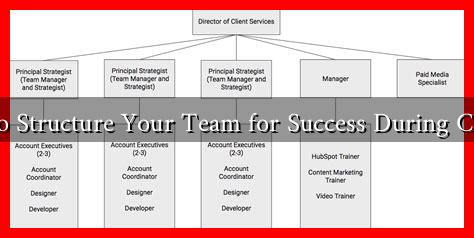-
Table of Contents
How to Structure Your Team for Success During Change
Change is an inevitable part of any organization, whether it’s due to market shifts, technological advancements, or internal restructuring. Successfully navigating these changes requires a well-structured team that can adapt and thrive. In this article, we will explore effective strategies for structuring your team to ensure success during periods of change.
Understanding the Need for Change
Before diving into team structure, it’s essential to understand why change is necessary. Organizations that fail to adapt often fall behind their competitors. According to a study by McKinsey, 70% of change initiatives fail, primarily due to employee resistance and lack of engagement. Recognizing the need for change can help leaders communicate effectively and prepare their teams for the transition.
Key Strategies for Structuring Your Team
To ensure your team is equipped to handle change, consider the following strategies:
- Define Clear Roles and Responsibilities: Clearly outline each team member’s role during the change process. This clarity helps prevent confusion and ensures accountability.
- Foster Open Communication: Encourage open dialogue among team members. Regular check-ins and feedback sessions can help address concerns and keep everyone aligned.
- Build a Diverse Team: A diverse team brings various perspectives and ideas, which can lead to innovative solutions during change. Consider including members from different departments or backgrounds.
- Empower Team Members: Give team members the autonomy to make decisions within their roles. Empowered employees are more likely to take ownership of their work and contribute positively to the change process.
- Provide Training and Resources: Equip your team with the necessary skills and tools to navigate change. This could include workshops, online courses, or access to industry resources.
Case Study: IBM’s Transformation
IBM is a prime example of a company that successfully restructured its teams during significant change. In the early 2000s, IBM faced declining revenues and increased competition. To address this, the company shifted its focus from hardware to software and services. This transformation required a complete overhaul of its team structure.
IBM implemented cross-functional teams that combined expertise from various departments, fostering collaboration and innovation. They also invested heavily in employee training, ensuring that their workforce was equipped to handle new technologies and methodologies. As a result, IBM not only survived the transition but emerged as a leader in the tech industry.
Utilizing Technology for Team Structure
In today’s digital age, technology plays a crucial role in team structure and communication. Tools like Slack, Microsoft Teams, and Asana can facilitate collaboration and keep everyone informed during times of change. Here are some ways to leverage technology:
- Project Management Tools: Use tools like Trello or Asana to track progress and assign tasks, ensuring everyone knows their responsibilities.
- Communication Platforms: Implement platforms like Slack for real-time communication, which can help address issues as they arise.
- Feedback Mechanisms: Utilize surveys or feedback tools to gauge employee sentiment and gather insights on the change process.
Measuring Success and Adjusting Strategies
Once your team is structured for change, it’s vital to measure the effectiveness of your strategies. Key performance indicators (KPIs) can help assess how well your team is adapting. Consider tracking:
- Employee engagement levels
- Project completion rates
- Customer satisfaction scores
Regularly review these metrics and be prepared to adjust your strategies as needed. Flexibility is key in a changing environment.
Conclusion
Structuring your team for success during change is a multifaceted process that requires clear communication, defined roles, and the right tools. By fostering a culture of collaboration and empowerment, organizations can navigate change more effectively. Remember the lessons from IBM’s transformation and leverage technology to enhance team dynamics. Ultimately, a well-structured team not only survives change but thrives in it, positioning the organization for long-term success.
For further reading on change management strategies, consider exploring resources from the Prosci Change Management organization.

